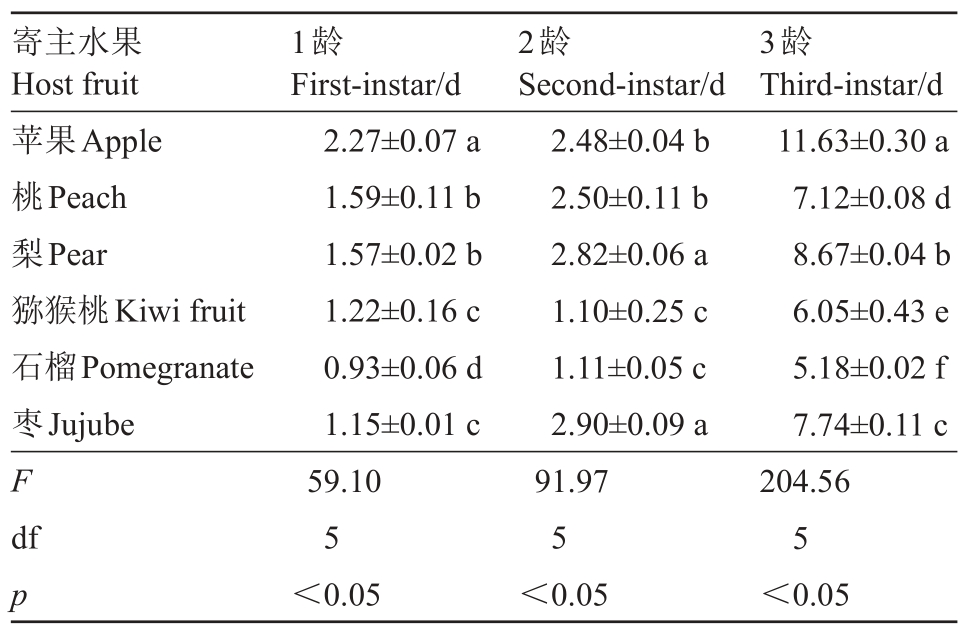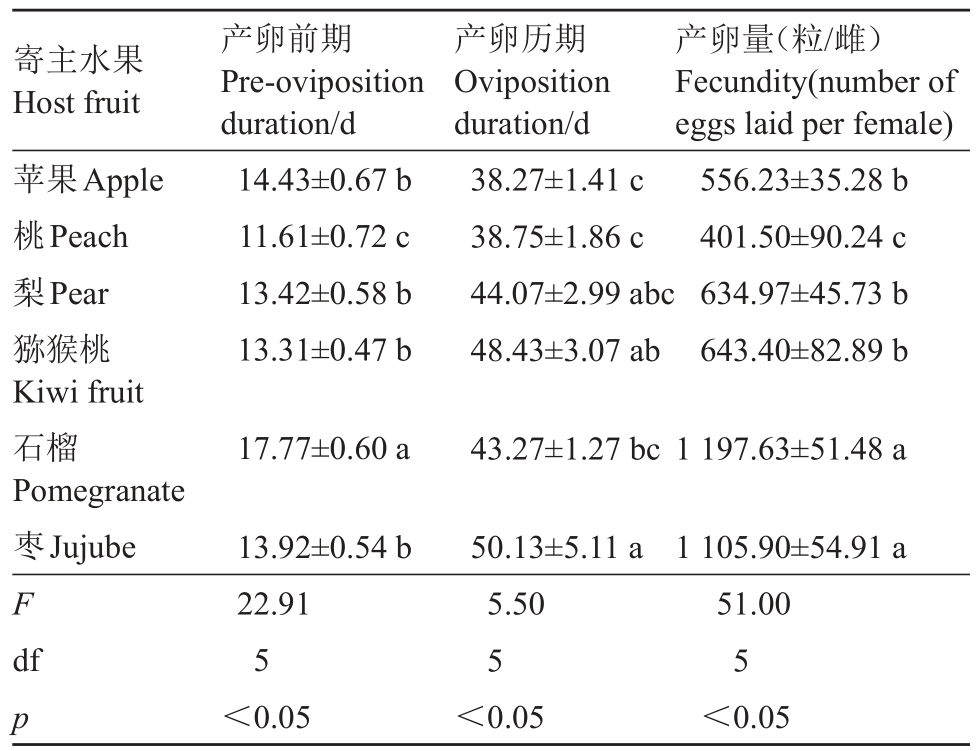橘小实蝇(Bactrocera dorsalis)属双翅目实蝇科,实蝇属,也称柑橘小实蝇、果蛆、东方果实蝇,主要以幼虫在果实内部进行危害,防治困难。寄主范围包括苹果、梨、番石榴、杧果、柑橘、桃、石榴、猕猴桃、枣等250 多种果蔬[1]。另外,其繁衍能力和适应寄主能力强,当其进入北方落叶果树种植区后,能够很快适应新的寄主,导致橘小实蝇危害的主要寄主转变为当地种植果树。1911年,橘小实蝇在中国台湾初次发现,中国大陆于1937年出现危害,之后,橘小实蝇在国内开始迅速传播[2-3]。1980 年前后在广西、云南等杧果、柑橘种植区域危害成灾,然后扩散至重庆、四川,2006年在湖北等中部地区发现危害,2009年在郑州发现橘小实蝇危害果园,2012年已传播至北京,扩散蔓延能力极强[4-5]。之前大量调查发现,橘小实蝇适宜发育繁殖地区为长江以南,而在1月平均温度处于-1 ℃以下的地域属于不适合橘小实蝇繁衍的区域[6]。近年来随着物流业的飞速发展、全球气候变化、种植结构的调整、栽培模式的改变等,田间调查发现橘小实蝇已经在长江以北连年发生,且近几年橘小实蝇在河南、山东、河北、北京等地危害逐年加重,在部分地域造成了非常严重的危害和经济损失[7-11]。另外,橘小实蝇已经不属于国内省份间病虫害检疫对象,种种因素都会导致橘小实蝇对北方地区果树产业的威胁变大。
在自然条件下,橘小实蝇的发育历期、孵化率、存活率等与寄主种类有着密切的关系[12],前人对南方番石榴、甜橙、杧果、香蕉等多种常绿果树上橘小实蝇的寄主适应性进行了大量的研究,表明杧果、番石榴为橘小实蝇较为偏好的寄主水果,在取食不同寄主情况下,橘小实蝇单头雌虫产卵量最多的为杧果、番石榴[13-17]。对橘小实蝇在南方落叶果树上危害特点的研究显示,橘小实蝇在桃、梨上的危害较为普遍,枣也是橘小实蝇偏爱的寄主植物[18-19]。橘小实蝇传入北方后,郭腾达等[20]对橘小实蝇危害3 种苹果进行风险评估,发现橘小实蝇对主栽苹果品种均可危害。郭晓军等[21]分析了北京、河北、河南等地桃园橘小实蝇的种群结构和危害特点。橘小实蝇在北方主栽落叶果树寄主适应性系统研究尚属空白。笔者以6 种北方主栽落叶果树为研究对象,应用生命表技术较详细地研究了6种不同寄主植物对橘小实蝇生长发育、存活和繁殖等生物学特性的影响,旨在评价橘小实蝇对北方落叶果树的危害风险,从而进行科学有效防控,保障果品的安全、高效生产。
1 材料和方法
1.1 供试植物
选取石榴(Punica granatum ,突尼斯软籽Tunisian soft-seed)、苹果(Malus pumila,富士Fuji)、梨(Pyrus sorotina,砀山梨Dangshan pear)、桃(Amygdalus persica,春美Spring Beauty)、猕猴桃(Actinidia chinensis,米良一号Miliang 1)、枣(Ziziphus jujuba,冬枣Winter jujube)6 种果树的新鲜成熟果实作为供试寄主材料。试验所用寄主水果均采自中国农业科学院郑州果树研究所果园。
1.2 供试虫源
供试橘小实蝇虫源2020年7月采自郑州郊区桃园春美品种桃树,采集后使用人工饲料于人工气候室连续饲养5代以上。
1.3 供试材料
人工饲料经过一定配比混制而成。幼虫人工饲料包括玉米面、麦麸、蔗糖、酵母、尼白金、盐酸、水;成虫人工饲料包括酵母粉、大豆蛋白、蔗糖、尼泊金、山梨酸、抗坏血酸。
1.4 卵的孵化率和发育历期
将6 种寄主水果完整果实置于养虫笼内,然后将100 头已交配的橘小实蝇雌成虫转移到笼内,使橘小实蝇产卵于果实内部。1 h 后,将寄主果实取出,用小刀轻微切开果实上的产卵孔,观察产卵情况。放于(28±1)℃,RH 75%±5% ,光周期16L:8D的培养箱中培养,3次重复。培养12 h后,开始每隔2 h检察1次幼虫孵化情况,直到连续检查3次均无卵孵化为止,未孵化的卵记为死亡。统计各种食料上卵的孵化率和发育历期。
1.5 幼虫的存活率和发育历期
取以上6 种寄主食料下孵化的幼虫各100 头,3次重复。用小毛笔将橘小实蝇初孵幼虫挑入塑料培养皿(直径5 cm)中相应的新鲜果块上,每皿5头,每个处理20皿,以相应的食料在(28±1)℃的黑暗条件下进行饲养,逐日更换食料。每天9:00 和21:00 时根据幼虫蜕皮情况及体型变化观察幼虫生长发育情况,直至化蛹或死亡为止。幼虫老熟后,打开培养皿盖子放于底部铺有2 cm厚沙土的塑料托盘内,以便老熟幼虫跳出培养皿后在沙土中化蛹。托盘外覆盖黑色湿布以保湿、遮光以及防止幼虫跳出托盘,逐日记录各种食料饲养下的幼虫化蛹数。
1.6 蛹的存活率和发育历期
将每天各种食料饲养条件下形成的蛹挑出,按不同的食料以及化蛹时间分装于底部铺有3 cm 厚疏松湿润沙土的塑料杯里,杯身标注食料种类以及化蛹日期,蛹的上面铺一层约2 cm 厚的薄沙土,以保鲜膜封口,并于杯身扎若干透气孔。
在(28±1)℃、RH 75%±5%、光周期16L:8D的培养箱内培养,逐日记录各供试食料下蛹的羽化数。
1.7 成虫产卵及卵期观察
收集不同寄主果实上羽化而来的成虫进行试验。取刚羽化的30对成虫,每10对放入一个养虫笼(20 cm × 20 cm × 20 cm)内使其进行交配,并用小盒放入成虫饲料以供成虫取食补充营养,通过装有寄主果实的产卵杯供成虫产卵。每天20:00时察看成虫的存活情况和产卵数量,记录雌成虫的产卵前期(羽化至产卵前)、产卵期(开始产卵至死亡)及总产卵数。
将12 h 内橘小实蝇雌虫产下的卵,放在塑料培养皿内的新鲜果块上观察卵的孵化,培养皿置于同一温湿度的培养箱中,每2 h 使用显微镜观察1 次。所有试验均于(28±1)℃、RH 75%±5%、光周期16L:8D条件下进行。
1.8 数据处理
1.8.1 种群参数计算方法 对不同寄主上橘小实蝇的发育繁殖情况进行记录,通过发育历期、存活数、死亡数、产卵数等数据构建橘小实蝇种群生命表,计算橘小实蝇在不同寄主植物上的种群动态参数。净增殖率R0=Σlxmx;世代平均周期T=Σxlxmx/R0;内禀增长率rm=ln R0/T;周限增长率λ=erm;种群加倍时间Dt=ln2/rm,其中lx是任一个个体在x 期间存活的概率,mx表示x期间平均每雌虫产雌数量。
1.8.2 数据统计分析 采用IBM Spss Statistics 19.0 软件进行数据统计分析。使用Excel 计算各参数平均数,不同寄主间的发育历期、存活率及种群动态参数均采用Duncan 法进行差异显著性分析(p<0.05)。
2 结果与分析
2.1 6种寄主植物对橘小实蝇发育历期的影响
不同寄主对橘小实蝇卵期、幼虫期、蛹期等发育历期的影响见表1。卵期,橘小实蝇在猕猴桃上的发育历期是最短的,为(0.68±0.22)d;在石榴上发育历期是最长的,为(1.11±0.01)d;但卵在桃、梨、枣和苹果上无显著差异。而在取食6 种寄主植物后,幼虫发育历期均存在显著差异,在石榴上最短,为(7.21±0.05)d;在苹果上幼虫发育历期最长,为(16.37±0.27)d。蛹期同样是在石榴上最短,为(9.82±0.04)d。橘小实蝇从卵发育到蛹的历期(F=124.25,p<0.05),在石榴、猕猴桃、桃、枣、梨及苹果上依次增加,分别为(18.15±0.07)d,(19.61±0.40)d,(22.24±0.19)d,(22.57±0.84)d,(24.30±0.15)d 和(27.42±0.36)d,存在显著差异。在幼虫期取食枣后的橘小实蝇寿命最长,平均存活时间最长可达(64.05±4.90)d;取食猕猴桃的成虫寿命次之,为(61.75±3.42)d;而取食桃的橘小实蝇成虫寿命最短,为(50.36±1.18)d。因为各个发育历期的差异,橘小实蝇全世代周期在6种寄主植物上也存在较为显著的差异,在桃、石榴、苹果、猕猴桃、梨和枣上全世代周期逐渐增加。
表1 橘小实蝇在6 种寄主植物上发育历期
Table 1 Developmental duration of Bactrocera dorsalis on six host plants

注:表中为平均值±标准差;数据后小写字母为同列比较,表示经Duncan 法检验差异显著(p<0.05)。下同。
Note:Data are mean±SD;the lower case letters after the data are compared in the same column,indicating that the difference is significant by Duncan method(p<0.05).The same below.
全世代Generation duration/d 80.12±1.73 ab 72.60±1.37 c 81.79±3.21 ab 81.35±3.27 ab 79.18±0.73 b 86.63±5.16 a 4.70 5<0.05寄主果实Host fruit苹果Apple桃Peach梨Pear猕猴桃Kiwi fruit石榴Pomegranate枣Jujube F df p卵期Egg duration/d 1.03±0.03 ab 0.84±0.11 bc 0.86±0.05 bc 0.68±0.22 c 1.11±0.01 a 0.96±0.04 ab 4.20 5<0.05幼虫期Larval duration/d 16.37±0.27 a 11.21±0.07 c 13.06±0.04 b 8.37±0.58 d 7.21±0.05 e 11.14±0.86 c 111.26 5<0.05蛹期Pupal duration/d 10.03±0.21 cd 10.18±0.02 bc 10.39±0.11 ab 10.56±0.16 a 9.82±0.04 d 10.47±0.16 ab 8.79 5<0.05成虫寿命Adult longevity/d 52.69±2.08 bc 50.36±1.18 c 57.49±3.21 ab 61.75±3.42 a 61.04±0.71 a 64.05±4.90 a 6.75 5<0.05
在各幼虫阶段,不同寄主上的橘小实蝇同样存在显著差异(表2)。橘小实蝇1 龄幼虫在石榴上的发育历期是最短的,为(0.93±0.06)d;在苹果上发育历期最长,为(2.27±0.07)d。而在2龄幼虫期,橘小实蝇在石榴和猕猴桃上较短,分别为(1.11±0.05)d和(1.10±0.25)d;在枣和梨上较长,分别为(2.90±0.09)d和(2.82±0.06)d。3龄幼虫期同样是在石榴上最短,为(5.18±0.02)d,显著短于其余5种寄主植物。
表2 橘小实蝇在6 种寄主植物上幼虫不同龄期的发育历期
Table 2 Developmental duration of Bactrocera dorsalis in larval stage on six host plants

寄主水果Host fruit苹果Apple桃Peach梨Pear猕猴桃Kiwi fruit石榴Pomegranate枣Jujube F df p 1龄First-instar/d 2.27±0.07 a 1.59±0.11 b 1.57±0.02 b 1.22±0.16 c 0.93±0.06 d 1.15±0.01 c 59.10 5<0.05 2龄Second-instar/d 2.48±0.04 b 2.50±0.11 b 2.82±0.06 a 1.10±0.25 c 1.11±0.05 c 2.90±0.09 a 91.97 5<0.05 3龄Third-instar/d 11.63±0.30 a 7.12±0.08 d 8.67±0.04 b 6.05±0.43 e 5.18±0.02 f 7.74±0.11 c 204.56 5<0.05
2.2 6种寄主植物对橘小实蝇各虫态存活的影响
由表3 可以看出,取食苹果、桃、梨、猕猴桃、石榴、枣6种不同的寄主植物,橘小实蝇卵的孵化率存在显著差异,在梨上卵的孵化率最高,为63.00%;猕猴桃上的次之,为42.67%;桃上的最低,为21.33%。化蛹率在不同寄主上也存在着显著差异,石榴上的最高,为96.39%;桃和猕猴桃上次之,分别为67.39%、66.96%;苹果上最低,为42.15%。幼虫存活率,也表现出显著的差异,取食石榴的最高,为79.67%;取食猕猴桃的存活率为52.67%;取食苹果的最低,为26.33%。幼虫期取食猕猴桃的橘小实蝇羽化率最低,为48.92%。橘小实蝇在生长发育过程中,受幼虫存活率及其化蛹率影响较大,因此取食石榴的橘小实蝇的全世代存活率显著高于其他寄主。
表3 橘小实蝇在6 种寄主植物上的存活情况
Table 3 Survivorship of Bactrocera dorsalis on six host plants

寄主水果Host fruit苹果Apple桃Peach梨Pear猕猴桃Kiwi fruit石榴Pomegranate枣Jujube F df p卵孵化率Egg hatchability/%31.67±5.56 bc 21.33±2.36 c 63.00±8.83 a 42.67±4.11 b 23.33±2.62 c 41.67±3.30 b 19.16 5<0.05幼虫存活率Survival rate of larvae/%26.33±0.94 d 41.33±2.62 c 31.00±3.74 d 52.67±3.09 b 79.67±3.68 a 30.33±4.78 d 71.57 5<0.05化蛹率Pupation rate/%42.15±0.84 d 67.39±2.44 b 54.58±5.24 c 66.96±3.39 b 96.39±1.70 a 54.82±4.20 c 62.38 5<0.05羽化率Emergence rate/%86.22±8.60 a 54.80±0.71 d 71.80±2.07 bc 48.92±4.55 d 67.58±4.64 c 79.24±1.08 ab 19.87 5<0.05世代存活率Survival rate from egg to adult/%18.67±1.70 b 18.00±0.82 b 18.67±3.40 b 23.33±0.94 b 47.33±5.73 a 20.67±3.86 b 24.37 5<0.05
根据橘小实蝇的发育历期及存活率,得出橘小实蝇在6种寄主植物上由初孵幼虫至成虫死亡的存活率曲线(图1)。由图1可以看出,橘小实蝇在6种寄主植物上幼虫期死亡率较高,曲线呈快速下降趋势。羽化后成虫期死亡率较低,存活曲线趋于平缓。结果表明,各寄主上在成虫期的死亡率基本相近,且都为较平缓的变化趋势。

图1 橘小实蝇在6 种寄主植物上的存活率曲线
Fig.1 Survival curves of Bactrocera dorsalis on six host plants
2.3 不同的寄主植物对橘小实蝇成虫繁殖的影响
苹果、桃、梨、猕猴桃、石榴、枣6 种不同的寄主植物对橘小实蝇雌虫产卵前期、产卵历期及每雌产卵量都产生了较大的影响(表4)。以石榴为寄主的橘小实蝇,其雌成虫产卵前期显著长于其他寄主,为(17.77±0.60)d;但幼虫取食桃的橘小实蝇其产卵前期显著短于其他寄主,为(11.61±0.72)d。以枣为寄主的橘小实蝇产卵历期最长,为(50.13±5.11)d,每雌平均产卵量为(1 105.90±54.91)粒;以苹果为寄主的橘小实蝇产卵历期最短,为(38.27±1.41)d,每雌平均产卵量为(556.23±35.28)粒。在幼虫时期取食石榴的橘小实蝇的每雌平均产卵量最多,为(1 197.63±51.48)粒;取食桃的橘小实蝇每雌平均产卵量最少,为(401.50±90.24)粒。结果表明石榴树和枣树有利于橘小实蝇种群的繁殖。
表4 橘小实蝇雌虫在6种寄主植物上的发育及繁殖情况
Table 4 Development and fecundity of Bactrocera dorsalis on six host plants

寄主水果Host fruit苹果Apple桃Peach梨Pear猕猴桃Kiwi fruit石榴Pomegranate枣Jujube F df p产卵前期Pre-oviposition duration/d 14.43±0.67 b 11.61±0.72 c 13.42±0.58 b 13.31±0.47 b产卵历期Oviposition duration/d 38.27±1.41 c 38.75±1.86 c 44.07±2.99 abc 48.43±3.07 ab产卵量(粒/雌)Fecundity(number of eggs laid per female)556.23±35.28 b 401.50±90.24 c 634.97±45.73 b 643.40±82.89 b 17.77±0.60 a 43.27±1.27 bc 1 197.63±51.48 a 13.92±0.54 b 22.91 5<0.05 50.13±5.11 a 5.50 5<0.05 1 105.90±54.91 a 51.00 5<0.05
2.4 橘小实蝇在不同寄主植物上实验种群生命表参数
根据在苹果、桃、梨、猕猴桃、石榴、枣这6 种不同的寄主植物所观察的种群繁殖情况,计算种群的世代平均周期(T)、种群加倍时间(Dt)、净增殖率(R0)、内禀增长率(rm)和周限增长率(λ)。从表5 可以看出,以石榴为寄主的橘小实蝇净增殖率和内禀增长率显著高于其他寄主上的橘小实蝇。内禀增长率,也就是最大瞬时增长速率,能够全面准确地反映种群发育繁殖情况,是衡量种群动态增长极其重要的参数。在(28±1)℃、RH 75%±5%、光周期16L:8D、食物充足的理想条件下,用石榴饲养的稳定年龄组配橘小实蝇种群的最大瞬时增长速率为0.131 7,每经过1 d 种群数量增长最大(1.140 8 倍),每经过一个世代种群增殖最大858.98 倍,完成一个世代的平均历期需要51.30 d。根据试验结果,在石榴上,橘小实蝇的周限增长率、内禀增长率和净增殖率高于其他寄主,而世代平均周期较短,且种群加倍时间也低,故在6种寄主中,橘小实蝇在石榴上发育繁殖适宜度最高。
表5 橘小实蝇在6 种寄主植物上的种群生命表参数
Table 5 Population dynamic parameters of Bactrocera dorsalis on six host plants

寄主果实Host fruit苹果Apple桃Peach梨Pear猕猴桃Kiwi fruit石榴Pomegranate枣Jujube净增殖率(R0)Net reproductive rate 266.99±40.16 b 431.48±103.70 b 422.48±100.93 b 432.70±38.99 b 858.98±27.38 a 744.29±78.51 a世代平均周期(T)Mean generation time 64.86±0.21 a 52.08±1.40 c 58.67±0.40 b 58.38±1.73 b 51.30±0.82 c 59.05±0.51 b内禀增长率(rm)Ntrinsic rate of increase 0.086 0±0.002 1 d 0.115 9±0.005 3 b 0.102 5±0.003 4 c 0.104 0±0.001 5 c 0.131 7±0.002 7 a 0.111 9±0.001 1 b周限增长率(λ)Finite rate of increase 1.089 8±0.002 3 d 1.122 9±0.006 0 b 1.108 0±0.003 8 c 1.109 6±0.001 7 c 1.140 8±0.003 1 a 1.118 4±0.001 2 b种群加倍时间(Dt)Doubling time 8.07±0.19 a 5.99±0.27 c 6.77±0.23 b 6.67±0.10 b 5.26±0.11 d 6.20±0.06 c
3 讨 论
目前对橘小实蝇的研究主要集中在南方常绿果树上,在落叶果树上的发生和危害情况研究较少,有学者对南方落叶果树和常绿果树混栽区的橘小实蝇危害情况进行研究,袁胜勇等[22]研究发现相对甜石榴橘小实蝇更偏好在番石榴上产卵,胡黎华[23]对橘小实蝇在重庆地区几种主要果蔬上的生长发育情况进行研究,发现橘小实蝇在桃上能较好地进行生长发育,但不及脐橙。而橘小实蝇在北方主栽落叶果树的寄主适应性尚未进行系统研究,橘小实蝇属杂食性害虫,在不同寄主上的生长发育存在着明显的适合度差异,笔者在本研究中应用生命表技术对橘小实蝇在苹果、梨、桃、猕猴桃、石榴、枣6 种落叶果树上的发育与繁殖情况进行了研究,结果显示,与石榴、桃相比橘小实蝇更偏向于常绿果树,但石榴、桃比苹果等落叶果树寄主更适宜橘小实蝇繁殖。
在昆虫的发育繁殖过程中,不同的寄主果实会决定昆虫的发育繁殖情况进而对其生活史特点造成影响[24-26]。本研究结果显示,6种寄主果实对橘小实蝇各虫态的发育有着不同程度的影响,石榴更适合橘小实蝇的发育繁殖,橘小实蝇幼虫在石榴上的存活率显著高于其他寄主上,而从卵到蛹的发育历期在石榴、猕猴桃、桃、枣、梨、苹果上依次增长,在石榴和枣上产卵量分别为1 221.47 粒/雌和1 106.60 粒/雌,橘小实蝇在石榴和枣上具有较高的净增殖率。而在石榴上,种群加倍时间短、橘小实蝇在石榴上的存活率与产卵量均较高,也表明橘小实蝇对石榴可能会造成较大危害,这一点在我国部分地区果园得到证实[27-28]。室内橘小实蝇在桃上幼虫阶段发育历期较短,生长较快,有着较高的净增值率和内禀增长率,且在北方果园中调查结果显示,橘小实蝇对桃的危害较为严重,说明桃是橘小实蝇较为适宜的落叶果树寄主[21]。昆虫幼虫生长发育情况与寄主植物中含的有益物质有关,从而影响成虫的繁殖能力[29]。关于6种寄主落叶果树果实中含有的物质及营养成分是否会对橘小实蝇发育繁殖产生影响需要进一步研究。
在自然条件下,寄主只是影响昆虫发育繁殖的因素之一,除此之外,温度、湿度及光照等都是重要因素,而各因素间相互影响共同调控[30-33]。笔者在本试验使用寄主水果在室内进行饲养,一定程度上反映了橘小实蝇在不同寄主果实上的生长发育情况,但与田间实际生产中橘小实蝇的发生状况会有一些差异:田间温度、湿度及光照等因素都处于变化的状态,而室内试验环境恒定单一;另外,由于室内饲养所用果实为采摘果实,与果树上的果实对比,发生了生理变化,或许会使得橘小实蝇在幼虫和成虫时期的发育历期出现一定的变化。以本研究为基础,开展综合因素对橘小实蝇的影响及田间观察试验均有待进一步深入研究。
4 结 论
橘小实蝇在6种落叶果树上均能完成世代生长发育,不同寄主对橘小实蝇卵期、幼虫期、蛹期、成虫寿命、全世代等发育历期影响显著,而幼虫时期的取食寄主对后续成虫产卵有着极大的影响。橘小实蝇对石榴具有很高的潜在危害性,在石榴生产过程中仍要引起高度的重视,另外,桃是较为适宜橘小实蝇生长发育的寄主。在北方落叶果树主产区需要做好橘小实蝇的监测和预警工作,科学精准防控,减少橘小实蝇在北方落叶果树主产区的危害。
[1]李燕,蒋巧根,朱江涛,翟秋红.桔小实蝇在果蔬上的发生规律及其防治方法[J].上海农业科技,2018(1):104-105.LI Yan,JIANG Qiaogen,ZHU Jiangtao,ZHAI Qiuhong. Occurrence regularity and control methods of citrus fruit fly on fruits and vegetables[J]. Shanghai Agricultural Science and Technology,2018(1):104-105.
[2]WAN X W,LIU Y H,ZHANG B. Invasion history of the oriental fruit fly,Bactrocera dorsalis,in the Pacific-Asia region:two main invasion routes[J].PLoS ONE,2012,7(5):1-10.
[3]梁光红,陈家骅,杨建全,黄居昌,季清娥.桔小实蝇国内研究概况[J].华东昆虫学报,2003,12(2):90-98.LIANG Guanghong,CHEN Jiahua,YANG Jianquan,HUANG Juchang,JI Qing’e.Advances in research of Bactrocera dorsalis (Hendel) in China[J]. East China Journal of Entomology,2003,12(2):90-98.
[4]屈海学,孙静双.北京地区橘小实蝇的生活习性观察[J].中国园艺文摘,2013(2):51-51.QU Haixue,SUN Jingshuang. Observation of the living habits of Bactrocera dorsalis[J]. Chinese Horticultural Abstracts,2013(2):51-51.
[5]朱俐遐,李桂珍,尧美英,甲卡拉铁,杜邦,李贵利,刘斌.4 种诱捕器对杧果园桔小实蝇的诱捕效果[J]. 热带农业科学,2018,38(9):53-56.ZHU Lixia,LI Guizhen,YAO Meiying,Jiakalatie,DU Bang,LI Guili,LIU Bin.Trapping effect of four trappers on oriental fruit fly (Bactrocera dorsalis) in mango plantations[J]. Chinese Journal of Tropical Agriculture,2018,38(9):53-56.
[6]吴宇芬.橘小实蝇的地理分布模型[J].福建农林大学学报(自然科学版),2005,34(2):168-171.WU Yufen.Geographical distribution model of citrus fruit fly[J].Journal of Fujian Agriculture and Forestry University (Natural Science Edition),2005,34(2):168-171.
[7]詹开瑞,赵士熙,朱水芳,周卫川,王念武.桔小实蝇在中国的适生性研究[J].华南农业大学学报,2006,27(4):21-25.ZHAN Kairui,ZHAO Shixi,ZHU Shuifang,ZHOU Weichuan,WANG Nianwu. Study on the adaptability of Bactrocera dorsalis in China[J]. Journal of South China Agricultural University,2006,27(4):21-25.
[8]尹英超,王勤英.警惕北方果园新害虫—桔小实蝇[J].河北农业,2014(11):48-49.YIN Yingchao,WANG Qinying. Beware of a new pest in northern orchards:citrus fruit fly[J].Hebei Agriculture,2014(11):48-49.
[9]ZENG Y Y,GADI V,REDDY P,LI Z H,QIN Y J,WANG Y N,PAN X B,JIANG F,GAO F,ZHAO Z H. Global distribution and invasion pattern of oriental fruit fly,Bactrocera dorsalis(Diptera:Tephritidae)[J].Journal of Applied Entomology,2019,143(3):165-176.
[10]宋来庆,刘美英,赵玲玲,唐岩,孙燕霞,刘学卿,张学勇,姜中武. 桔小实蝇在烟台果树产区的监测与防控[J]. 烟台果树,2019(2):36-37.SONG Laiqing,LIU Meiying,ZHAO Lingling,TANG Yan,SUN Yanxia,LIU Xueqing,ZHANG Xueyong,JIANG Zhongwu. Monitoring and control of citrus fruit fly in Yantai fruit tree producing area[J].Yantai Fruits,2019(2):36-37.
[11]孙瑞红,宫庆涛,叶宝华,高兴文,尹燕雷.警惕柑桔小实蝇入侵危害山东果树[J].落叶果树,2017,49(6):38-39.SUN Ruihong,GONG Qingtao,YE Baohua,GAO Xingwen,YIN Yanlei.Guard against the invasion of citrus fruit fly and endanger fruit trees in Shandong[J]. Deciduous Fruits,2017,49(6):38-39.
[12]全金成,万保雄,江一红,门有均,黄金盟,陈贵峰,陆温,郑霞林.不同生境下橘小实蝇种群消长规律及其与气象要素的相关性[J].果树学报,2019,36(6):785-792.QUAN Jincheng,WAN Baoxiong,JIANG Yihong,MEN Youjun,HUANG Jinmeng,CHEN Guifeng,LU Wen,ZHENG Xialin. Population dynamics of Bactrocera dorsalis Hendel at different habitats in relation to meteorological factors[J].Journal of Fruit Science,2019,36(6):785-792.
[13]林进添,梁广文,陆永跃,曾玲.温度和寄主植物对桔小实蝇成虫主要生物学参数的影响[J].环境昆虫学报,2014,36(1):2-11.LIN Jintian,LIANG Guangwen,LU Yongyue,ZENG Ling. Effect of hosts and temperature on biological parameters of Bactrocera dorsalis (Hendel) adult[J]. Journal of Environmental Entomology,2014,36(1):2-11.
[14]张清源,林振基,刘金耀,陈华忠,高泉准,孙国坤,洪赞侨,孙德华,陈加福.桔小实蝇生物学特性[J].华东昆虫学报,1998(2):65-68.ZHANG Qingyuan,LIN Zhenji,LIU Jinyao,CHEN Huazhong,GAO Quanzhun,SUN Guokun,HONG Zanqiao,SUN Dehua,CHEN Jiafu. Study on the biology of oriental fruit fly[J]. Entomological Journal of East China,1998(2):65-68.
[15]袁盛勇,肖春,孔琼,陈斌,李正跃,高永红.桔小实蝇的产卵选择性[J].江西农业大学学报,2005(1):81-84.YUAN Shengyong,XIAO Chun,KONG Qiong,CHEN Bin,LI Zhengyue,GAO Yonghong. Oviposition selectivity of Bactroc-era dorsalis[J]. Acta Agriculturae Universitatis Jiangxiensis,2005(1):81-84.
[16]林进添,曾玲,宾淑英,梁广文,吴仕豪.桔小实蝇自然种群生命表的组建与分析[J]. 华中农业大学学报,2005,24(2):138-142.LIN Jintian,ZENG Ling,BIN Shuying,LIANG Guangwen,WU Shihao.The construction and analysis of natural population life table of Bactrocera (Bactrocera) dorsalis (Hendel)[J]. Journal of Huazhong Agricultural University,2005,24(2):138-142.
[17]付佑胜,赵桂东,潘建平,王沫,田世尧.果实酸度对橘小实蝇羽化作用影响的初探[J].长江大学学报(自然科学版),2005,2(5):15-16.FU Yousheng,ZHAO Guidong,PAN Jianping,WANG Mo,TIAN Shiyao.The effect of fruit pH on pupation and emergence of Bactrocera dorsalis(Hendel)[J].Journal of Yangtze University(Natural Science Edition),2005,2(5):15-16.
[18]全金成,陈贵峰,江一红,黄金盟,门友均,林清,容仁学,陈德毓,王绍斌,莫明全,黄自勇.广西桃李梨桔小实蝇为害调查及其田间防控试验[J].中国南方果树,2019,48(6):86-91.QUAN Jincheng,CHEN Guifeng,JIANG Yihong,HUANG Jinmeng,MEN Youjun,LIN Qing,RONG Renxue,CHEN Deyu,WANG Shaobin,MO Mingquan,HUANG Ziyong. Damage investigation and field control experiment of citrus fruit fly in peach,plum and pear in Guangxi[J]. South China Fruits,2019,48(6):86-91.
[19]袁梦,王波,宋采博,荣秀莲,尹颖.气候因子和寄主植物对苏州桔小实蝇种群动态的影响[J].安徽农业科学,2008,36(22):9619-9621.YUAN Meng,WANG Bo,SONG Caibo,RONG Xiulian,YIN Ying. Effects of climatic factors and host plants on the population dynamics of Bactrocera dorsalis in Suzhou[J]. Journal of Anhui Agricultural Sciences,2008,36(22):9619-9621.
[20]郭腾达,姜莉莉,孙瑞红,宫庆涛,叶保华.橘小实蝇危害3 种苹果的风险评估[J].果树学报,2021,38(2):231-241.GUO Tengda,JIANG Lili,SUN Ruihong,GONG Qingtao,YE Baohua.Risk evaluation of three apple cultivars affected by Bactrocera dorsalis[J]. Journal of Fruit Science,2021,38(2):231-241.
[21]郭晓军,徐庆宣,王甦,张帆.桃园橘小实蝇种群结构与发生危害调查[J].果树学报,2021,38(6):967-974.GUO Xiaojun,XU Qingxuan,WANG Su,ZHANG Fan.Population structure and occurrence of Bactrocera dorsalis in peach orchards[J].Journal of Fruit Science,2021,38(6):967-974.
[22]袁盛勇,肖春,孔琼,陈斌,李正跃,高永红.桔小实蝇的产卵选择性[J].江西农业大学学报,2005,27(1):81-84.YUAN Shengyong,XIAO Chun,KONG Qiong,CHEN Bin,LI Zhengyue,GAO Yonghong. Oviposition preference of Bactrocera dorsalis Hendle[J]. Acta Agriculturae Universitatis Jiangxiensis,2005,27(1):81-84.
[23]胡黎华. 寄主转换对橘小实蝇种群动态和抗氧化酶系的影响[D].重庆:西南大学,2011.HU Lihua. The influence of host plant switching on population dynamics and antioxidases activity of Bactrocera (Bactroeera)dorsalis(Hendel)[D].Chongqing:Southwest University,2011.
[24]李定旭,侯月利,沈佐锐.不同寄主植物对山楂叶螨生长发育和繁殖的影响[J].生态学报,2005,25(7):1562-1568.LI Dingxu,HOU Yueli,SHEN Zuorui. Influence of host plant species on the development and reproduction of hawthorn spider mite Tetranychus viennensis Zacher[J].Acta Ecologica Sinica,2005,25(7):1562-1568.
[25]李定旭,雷喜红,李政,高灵旺,沈佐锐.不同寄主植物对桃小食心虫生长发育和繁殖的影响[J].昆虫学报,2012,55(5):554-560.LI Dingxu,LEI Xihong,LI Zheng,GAO Lingwang,SHEN Zuorui. Effects of different host plants on the development and reproduction of the peach fruit borer,Carposina sasakii Matsumura (Lepidoptera:Carposinidae)[J]. Acta Entomologica Sinica,2012,55(5):554-560.
[26]李伟,郭慧芳,王荣富,刘宝生,钟万芳,方继朝.不同寄主植物上灰飞虱种群生命表的比较[J].昆虫学报,2009,52(5):531-536.LI Wei,GUO Huifang,WANG Rongfu,LIU Baosheng,ZHONG Wanfang,FANG Jichao. Comparison of life tables of Laodelphax striatellus (Homoptera:Delphacidae) on different host plants[J].Acta Entomologica Sinica,2009,52(5):531-536.
[27]张锡,杨秋艳,付启春,彭磊.桔小实蝇在云南蒙自地区的发生规律研究[J].中国果菜,2020,40(4):68-73.ZHANG Xi,YANG Qiuyan,FU Qichun,PENG Lei. Study on the occurrence regularity Bactrocera dorsalis Hendel in Mengzi city of Yunnan province[J]. China Fruit & Vegetable,2020,40(4):68-73.
[28]尹康,白耀玲,李黎. 桔小实蝇对蒙自农业产业的为害和防治[J].农技服务,2016,33(18):70.YIN Kang,BAI Yaoling,LI Li. Damage and control of citrus fruit fly to Mengzi agricultural industry[J].Agricultural Technology Service,2016,33(18):70.
[29]娄永根,程家安.植物-植食性昆虫-天敌三营养层次的相互作用及其研究方法[J].应用生态学报,1997,8(3):325-331.LOU Yonggen,CHENG Jia’an. Interactions among host plantsphytophagous insects and natural enemies and relevant research methods[J]. Chinese Journal of Applied Ecology,1997,8(3):325-331.
[30]余杰颖,任轲亮,薛文鹏,李添群,汪雪俊,耿坤.贵阳市猕猴桃园桔小实蝇种群动态及影响因子研究[J]. 天津农业科学,2021,27(12):55-58.YU Jieying,REN Keliang,XUE Wenpeng,LI Tianqun,WANG Xuejun,GENG Kun. Population dynamics and influencing factor of Bactrocera dorsalis in kiwifruit orchard in Guiyang city[J].Tianjin Agricultural Sciences,2021,27(12):55-58.
[31]邵仕芳,吴毅歆,何鹏飞,周跃能,何月秋.云南河口桔小实蝇成虫数量变化与气象因子关系研究[J].农业与技术,2021,41(4):16-20.SHAO Shifang,WU Yixin,HE Pengfei,ZHOU Yueneng,HE Yueqiu. Study on the relationship between the change of adult number of citrus fruit fly and meteorological factors in the estuary of Yunnan province[J].Agriculture and Technology,2021,41(4):16-20.
[32]翟秋红,倪萌,徐丽君.无锡地区桔小实蝇发生规律及影响因子的研究[J].现代园艺,2018(19):150-151.ZHAI Qiuhong,NI Meng,XU Lijun. Study on the occurrence law and influencing factors of citrus fruit fly in Wuxi[J]. Contemporary Horticulture,2018(19):150-151.
[33]邢楚明,韩冬银,张方平,牛黎明,符悦冠.气象因子对杧果园桔小实蝇种群动态的影响[J].热带农业科学,2017,37(4):48-51.XING Chuming,HAN Dongyin,ZHANG Fangping,NIU Liming,FU Yueguan. Effect of climatic factors on population dynamics of Bactrocera dorsalis in mango plantation[J]. Chinese Journal of Tropical Agriculture,2017,37(4):48-51.